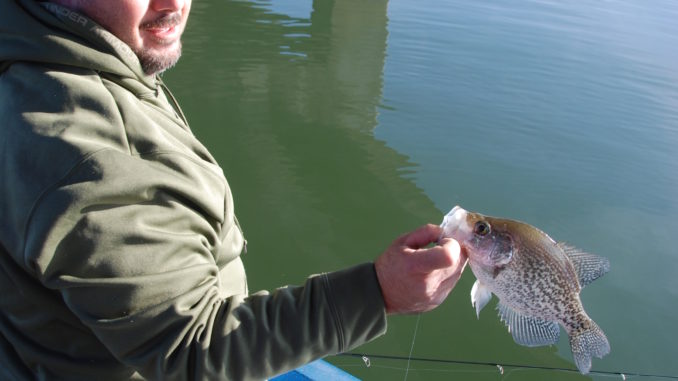
Lake Hartwell isn’t known for crappie because it doesn’t look like a crappie lake, but those in the know simply move deeper and catch loads of the tasty fish.
For years, Lake Hartwell has maintained a strong reputation as a largemouth bass and striper reservoir. Its 56,000 acres of deep, clear, open water and an abundant forage base of blueback herring and threadfin shad have made for great fishing for both species. Even the on-and-off drought that began a decade ago hasn’t done much to curtail those two fisheries.
Through it all, Hartwell’s abundant crappie population has been swimming under the radar. They tend to be overlooked and underfished, and the reason is a matter of perception.
“A lot of lake property owners fish for crappie from their own docks,” said biologist Dan Rankin of the S.C. Department of Natural Resources. “These days, many of those docks don’t have enough water to support crappie — if they have water at all. The second thing is that there’s not a lot of shoreline cover at Hartwell that you’ll see at other better-known crappie lakes like Russell or Greenwood.”
Despite everything you know about springtime fishing, crappie in Lake Hartwell — just like largemouth and striped bass — have become adept at making a living offshore. They exist and thrive where most anglers never bother to look for them. Other than deepwater boat docks, two main types of structure support a large number of crappie at Hartwell: bridges and man-made brush piles.
Viewed from above, Hartwell is shaped like a pitchfork, with three prongs protruding north from the main lake. While crappie are found all over the lake, the majority of fish, especially in the spring, will be found in one of those prongs, according to crappie-tournament pro Jay Bruce and guide Steve Crenshaw.
Bruce, a resident of Greer who fishes tournaments all over the Southeast using a variety of techniques, concentrates on fishing around the bridges that span many of Hartwell’s tributaries he stays “home” to fish. He said the lake holds a population of fish that spend the entire year, including the spawn, holding around bridge pilings.
“I start fishing for crappie on Lake Hartwell bridges at the beginning of February,” Bruce said. “The fish stay there all year. In February, they begin a prespawn. The fish will move into a little bit deeper water because the water is so clear. A little colder water will push the fish down a little deeper, but you’ll start seeing more fish around the bridges in the creeks by mid-February to early March and then, by mid-March to late March, you’ll start catching fish that are spawning on the bridges.”
Bruce has his search for crappie down to a science. He uses the latest in side-imaging sonar to identify where crappie are positioned on a bridge before he ever wets a hook.
“I will motor through a bridge before I fish it,” he said. “I have a side-imaging sonar unit on my boat, and I simply steer the boat in between the bridge columns to see where the fish are. Boats motor through all the time, so it doesn’t bother the fish. Their location can vary from day to day, and especially from season to season. In wintertime, they’re deeper. In springtime, they’ll be shallower. I start looking in anywhere from 20 to 40 feet of water. The side imaging allows me to pick out which columns the fish are holding on and at what depth. It narrows it down very, very quickly which ones you need to fish.”
After a quick once-through and some mental notes about which columns to fish and what depth to target, Bruce breaks out a 6-foot, ultra-light spinning rod and reel spooled with 4-pound Magnathin mono. On the business end, he ties a 1/32- to 1/16-ounce jighead, depending on how fast the fish want the jig falling. He always uses a Kalin shad-body jig, usually in a clear to a blue-white color.
“I try to position my boat on the downwind side of the bridge, just to make boat control a little easier,” he said. “If at all possible, I stay on the shaded side of the bridge so I’m not throwing a shadow into the clear water. I don’t like to get under the bridge very much. I don’t like to get over the fish under the bridge, because in Hartwell’s clear water, you’ll spook the fish. You might catch some smaller fish that way, but very rarely will you ever catch the bigger fish. I like to stay on the outside and cast parallel with the column and let the jig sink on a slack line. I’m watching the line for that little tick that signals a crappie has sucked it in.”
Bruce prefers Hartwell’s middle prong, the Seneca River. He admits it’s a matter of personal preference, and that he’s had similar experiences on the Tugaloo River and Six-And-Twenty arms as well.
“I start out at Martin’s Creek; that’s where I’m more comfortable fishing because I know how those fish hang out,” he said. “I also like Coneross, the Seneca Creek arm, the (SC) 123 bridge and the (SC) 93 bridge that comes out of Clemson.”
On most days between February and April, you’ll find Crenshaw (864-608-2763) somewhere on the Tugaloo River, fishing brushpiles. Every other year, he spends several weeks during the winter planting man-made brush piles to attract crappie so he can come back later with his clients and catch them.
“In mid- to late February, crappie will be on brush in the back half of stained creeks,” he said. “Starting about the second week of March, they’ll be on brush piles on the main part of the Tugaloo arm and in the clear-water runs. In both of these patterns, the fish will be in water from six to 15 feet deep.”
Crenshaw goes on to explain the difference between what he calls a “stained water creek” and an area that has clearer water.
“Gumlog Creek is a stained one,” he said. “Fair Play, Shoal Creek, Choestoea and Little Choestoea, and Eastanollee are stained creeks. Those are ones I like to fish early in the year.”
Crenshaw goes on to describe a clear-water run as not so much of a named creek, but a dead-end cove or neck that has no real flowing water coming into it.
“Fish in the necks and coves next,” he said. “I have a lot better luck fishing the necks and coves that run off of the main river; most of them don’t have names, and there’s no real water coming into them. Those places also tend to get less people fishing in them than a named creek, like Gumlog or Eastanolle.”
Like Bruce, Crenshaw is not a big fan of positioning his boat right on top of the location he wants to fish. His strength is either casting jigs over the tops and to the sides of the structure or fishing a live minnow under a slip bobber to tempt the fish. He finds there are days when the fish will show a definite preference.
“Once I mark a brush pile with my graph, I’ll back off of it and anchor,” said Crenshaw. “Depending on how deep that brush pile is, I’ll just put on a float, one that clips on, and use a jig or minnow, if it’s from the surface down to three or four feet. But if it’s five, six or 10 foot below the surface, I’ll use a slip cork and a minnow.”
Crenshaw said he catches a mixture of white and black crappie in different areas of Hartwell.
“I probably catch (half-and-half) white and black crappie over here,” said Crenshaw. “It’s definitely a mix. It seems like there are more white crappie on the Tugaloo than there are on the South Carolina side. Most people don’t care. What they do care about is if they can eat them or not. Since there is no fish consumption advisory on crappie on this side, that’s where I do my crappie fishing.”
DESTINATION INFORMATION
HOW TO GET THERE: The US Army Corps of Engineers maintains a number of public boat ramps that can be found on the internet by accessing their site at www.sas.usace.army.mil/lakes/hartwell.
BEST TACTICS: Prespawn crappie show a definite preference for two types of offshore structure in Lake Hartwell, where low water levels and a lack of shoreline cover often keep nearshore waters devoid of crappie. The numerous bridge crossings that span the lake will hold crappie year-round and offer a wide variety of depths that hold fish. Man-made brushpiles in stained creeks and clear coves also hold fish. Back off from either cover and cast live minnows or jigs to the cover. Floats are optional, depending on depth and cover fished.
GUIDES/FISHING INFO: Steve Crenshaw, 864-608-2763, www.lakehartwellfishingcharters.com; Lake Hartwell Fishing & Marina, Anderson, 864-287-9782; Grady’s Great Outdoors, Anderson, 864 -226-5283. See also Guides & Charters in Classifieds.
ACCOMMODATIONS: Anderson County Convention and Visitor’s Bureau, 877-282-4650, www.visitanderson.com; Mountain Lakes Convention and Visitor’s Bureau, 877-685-2537, www.scmountainlakes.com.
MAPS: Delorme South Carolina Atlas & Gazetteer, 800-561-5105 or www.delorme.com; Fishing Hot Spots, 800-ALLMAPS, www.fishinghotspots.com; Kingfisher Maps, Clemson, 800-326-0257 or www.kfmaps.com.

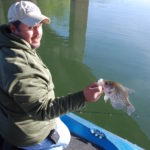
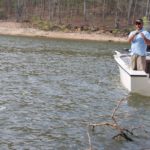
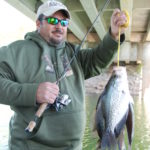
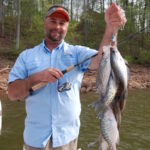
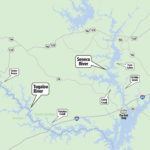

Be the first to comment